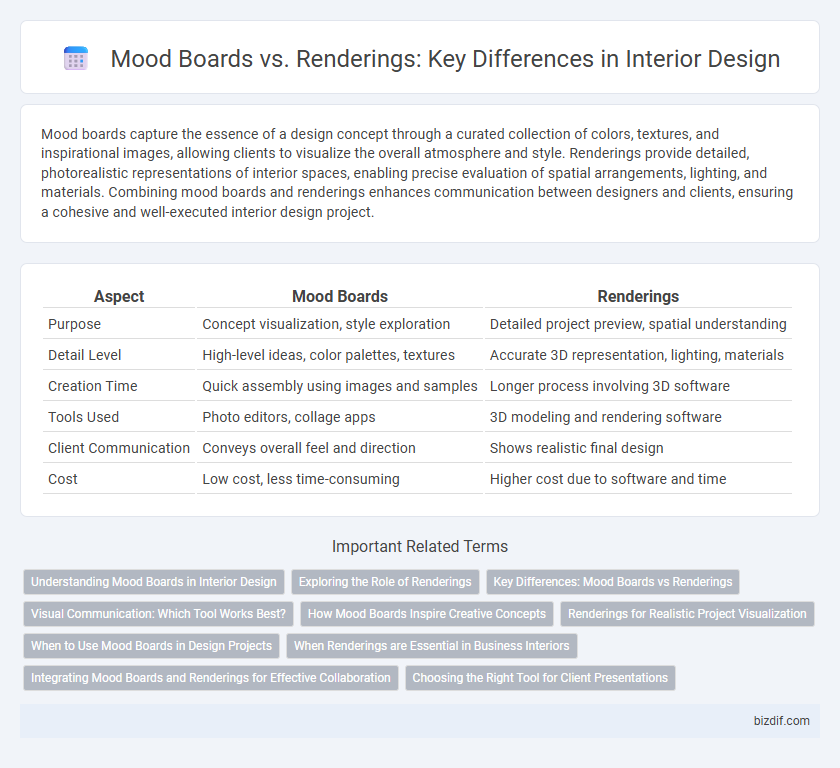Mood boards capture the essence of a design concept through a curated collection of colors, textures, and inspirational images, allowing clients to visualize the overall atmosphere and style. Renderings provide detailed, photorealistic representations of interior spaces, enabling precise evaluation of spatial arrangements, lighting, and materials. Combining mood boards and renderings enhances communication between designers and clients, ensuring a cohesive and well-executed interior design project.
Table of Comparison
| Aspect | Mood Boards | Renderings |
|---|---|---|
| Purpose | Concept visualization, style exploration | Detailed project preview, spatial understanding |
| Detail Level | High-level ideas, color palettes, textures | Accurate 3D representation, lighting, materials |
| Creation Time | Quick assembly using images and samples | Longer process involving 3D software |
| Tools Used | Photo editors, collage apps | 3D modeling and rendering software |
| Client Communication | Conveys overall feel and direction | Shows realistic final design |
| Cost | Low cost, less time-consuming | Higher cost due to software and time |
Understanding Mood Boards in Interior Design
Mood boards in interior design serve as visual tools that compile colors, textures, materials, and inspirational images to establish the overall aesthetic and emotional tone of a space. They facilitate communication between designers and clients by providing a cohesive snapshot of style concepts before detailed planning begins. Understanding mood boards allows designers to align client expectations and streamline the creative process, ensuring that the final design reflects the intended mood and atmosphere.
Exploring the Role of Renderings
Renderings play a crucial role in interior design by providing realistic, detailed visualizations that bring mood board concepts to life. They allow designers and clients to assess spatial arrangements, lighting, textures, and color schemes before actual implementation, reducing costly mistakes. High-quality 3D renderings enhance communication and decision-making, ensuring the final design meets expectations accurately.
Key Differences: Mood Boards vs Renderings
Mood boards visually communicate the conceptual atmosphere and style through curated images, textures, and color palettes, helping clients envision the overall design theme. Renderings provide detailed, photorealistic 3D visualizations of interior spaces, showcasing precise spatial arrangements, materials, and lighting effects. The key difference lies in mood boards emphasizing abstract inspiration and emotional tone, while renderings focus on accurate, measurable design execution.
Visual Communication: Which Tool Works Best?
Mood boards excel in visual communication by presenting a cohesive collection of textures, colors, and materials that convey the overall design mood and aesthetic. Renderings provide highly detailed, realistic 3D representations of the space, allowing clients to visualize spatial relationships and lighting effects accurately. Choosing between mood boards and renderings depends on whether the goal is to inspire with conceptual ideas or to communicate precise design details.
How Mood Boards Inspire Creative Concepts
Mood boards serve as a powerful tool in interior design by visually compiling textures, colors, and materials that stimulate creative concepts and guide aesthetic decisions. Unlike renderings, which present finalized digital representations of a space, mood boards foster experimentation and exploration of design themes in an intuitive format. This process enhances collaboration between designers and clients, ensuring the creative vision aligns with personal style and functional needs.
Renderings for Realistic Project Visualization
Renderings provide highly detailed and photorealistic images that allow clients and designers to visualize interior spaces with accurate lighting, textures, and materials. Unlike mood boards, which offer conceptual ideas and color palettes, renderings enable precise evaluation of spatial arrangements and design elements before construction. This realistic project visualization reduces costly revisions and enhances communication among stakeholders throughout the interior design process.
When to Use Mood Boards in Design Projects
Mood boards are essential in the initial phases of interior design projects to establish and communicate the overall aesthetic, color schemes, and material textures. They facilitate collaboration between designers and clients by providing a tactile and visual reference that guides the creative direction before detailed plans or digital renderings are developed. Using mood boards early helps streamline decision-making and ensures alignment on style preferences, reducing costly revisions during later stages.
When Renderings are Essential in Business Interiors
Renderings are essential in business interiors when precise visualization of spatial layouts, lighting, and materials is required to align client expectations with design outcomes and facilitate decision-making. They enable stakeholders to experience the proposed environment realistically, highlighting functional elements such as furniture placement and traffic flow that mood boards cannot fully convey. High-quality 3D renderings also reduce costly revisions by providing a detailed preview before construction begins.
Integrating Mood Boards and Renderings for Effective Collaboration
Integrating mood boards and renderings enhances interior design collaboration by combining conceptual inspiration with detailed visualization, allowing stakeholders to align on color schemes, textures, and spatial layouts early in the process. Mood boards convey the emotional tone and style through curated imagery and material samples, while renderings provide photorealistic 3D depictions of the design, facilitating precise adjustments and client approvals. This synergy streamlines communication, reduces revisions, and ensures cohesive execution from concept to final installation.
Choosing the Right Tool for Client Presentations
Mood boards offer a tactile and visual compilation of textures, colors, and materials, helping clients grasp the overall aesthetic direction of an interior design project. Renderings provide photorealistic, detailed 3D visualizations that allow clients to experience spatial layouts and lighting effects before execution. Selecting the right tool depends on client preferences and project complexity, with mood boards ideal for initial concept discussions and renderings suited for precise final presentations.
Mood Boards vs Renderings Infographic

 bizdif.com
bizdif.com